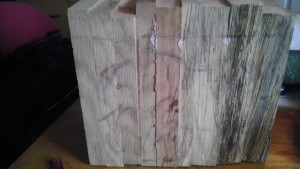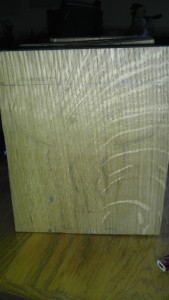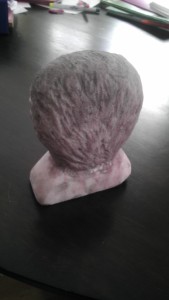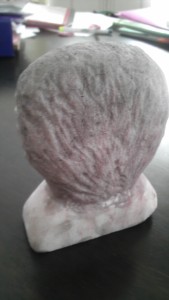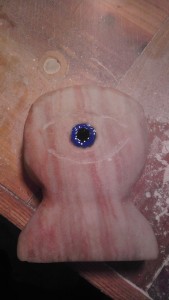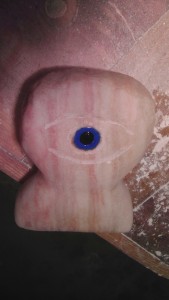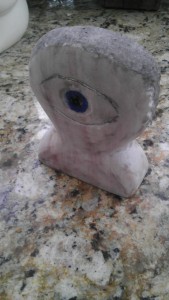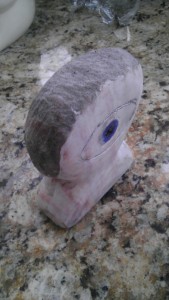One of the earlier things I wanted to do, a desire born probably around the age of ten years old but never abandoned, was to be able to sculpt stone. This wish arose both from an even older almost intrinsic love of stone, it’s strength and truthfulness and beauty, as well as the things I began to observe as being wrought from stone. That summer of 1972 we had moved to a new town (West Bay Shore) and one of the things one does (or did) was get a library card. The first two series of books I took out were high class picture books on both the history of World War II and on the works of great artists and sculptors. Rodin and Michelangelo were very impressive and so was the idea that one could represent the imagination in stone. Nigh on formative.
Recently my nephew was visiting and I wanted to demonstrate the power of an angle grinder with a kutz-all disc on it, so I took a piece of alabaster I had lying around, put it in the wood vice, vrrm, vrrm, and a very impressive hollow appeared almost instantly. I was struck by how fast that was, as in the sculpting of stone, from my limited experience, the gross removal of material is the cumbersome part. I made a note that I’d make something out of this particular block just to try a few things.
I call this post a detour because I had actually gone to the workshop to make the first shaping of the oaken elephant I’ve been planning. The alabaster was in the vice that I was to put the oak block in. ADHD. How could I remove the alabaster without working on it? I could not.. Speaking briefly of that elephant, you might have to click on the pictures below, but you should certainly be able to see both side and front views.
Anyway, so the elephant had to get in line. This alabaster block, I drew a circle on it, and beneath that a triangle, and all I really first thought was to use various tools to flesh out (subtractively) those shapes. The angle grinder makes very short work of alabaster – I think for an outside project though, as opposed to in a closed workshop where the air quality rapidly deteriorates and smoke alarms quickly get set off. Also it’s noisy to the point of obscuring thought. Usually I listen to music and think as I make things. In the future I’d save the use of the angle grinder for cases where a lot of material wants to be removed quickly and it’s outdoors.
After I unplugged the fire alarm I mused as the dust cleared, and finally, thinking Cyclops really, I sketched an eye in the circle. When I brought the one-eyed circle triangle rough upstairs that night my younger daughter said, oh, it’s an Illuminati. I did not know that there were such things (not counting ancient secret societies and/or conspiracy theories) as creatures but decided to run with it. Really my purpose was mostly to discover how certain tools, it didn’t matter here what I made so much as the observations while making. 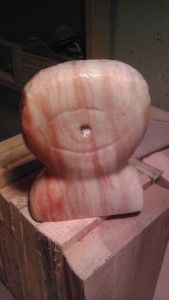
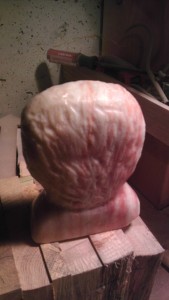
I figured if you take the nose and mouth away from a cyclops, just leave the eye, that can be an Illumati. For the purposes of explaining how such creatures survive, their exceedingly sensitive and specialized eye absorbs the energy of the light it beholds and transforms that into electricity. That powers their immense cognitive apparatus (far more efficient than ours, as the in their model the thing perceived actually creates the energy for thought) AND the little energy they devote to their specific physical incarnation. An Illuminati with hair as rich as this one
probably took a very long time to get that way. But let’s leave the ponderous bits aside for a moment.
A standard flat and round file/rasp combo was very quick to cut this stone (I think it’s a Moh’s hardness rating of 2), as was a farriers rasp I had on hand. I had a Dremel tool with a pea-size kutz-all ball bit that was almost as easy to use as a magic marker, as far as making lines. What surprises me most though was how a simple orbital sander with grits ranging from 60 to 220 readily put silky polish on the stone. A stone like this really shames the reputation of stone as being harder than wood, because it’s not. Nonetheless, at a hardness like this I can’t see how anyone can say that tools limit their ability to shape stone. The files, rasps and, and sandpaper were perfectly adequate. An awl could have done that the Dremel did. Because of this experience I really have to open my thinking to the idea that the real limit is more conception than execution, that sure, you could think of things so wispy that the stone could not hold the form, stallions rearing on two feet as well would not work, but most things will be fine.
So back then, for a moment, to this imaginary creature. I kept wondering how it would advantaged or disadvantaged by having only one eye. No stereopsis (fancy for binocular vision) as least real time anyway, as models could be made by memory and traversal. It’s the immediacy though, which of course leads the wandering mind, a la Flatland, to the mind of a fly – if flies have minds as we understand them, and whether the idea of a two dimensional reduction of the multidimensional world would seem such a non-starter, as only the barest hint of the underlying reality is so portrayed. But enough of these conjectures. I think the singularity of perspective, at least in the immediate sense, maps as a scary quality. Maybe cyclopes needed to move about more, to obtain the multiple angles we take for granted. Maybe this need to act to obtain perspective made them wiser, recognizing that a single point of view was not enough; maybe it made them more circumspect, less inclined to think that to see was to know.
What a Cyclops knows, he knows by heart. Such has been this alabaster detour.

